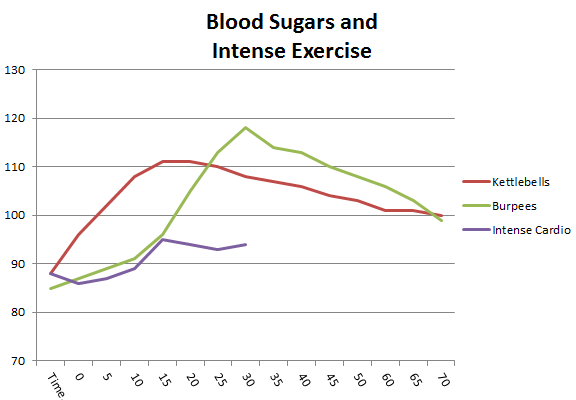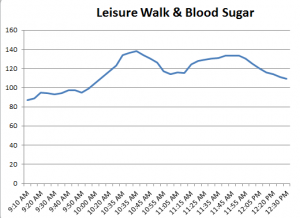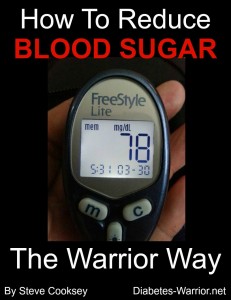Diabetes & Exercise, what you need to know. Exercise is an important tool in your diabetes toolkit, you should know how to use it. I promote a twin pillar approach to successfully managing diabetes, a proper diabetes diet and exercise.
- Different exercises will affect blood sugars differently
- Walking is great exercise for reducing blood sugars
On the chart below, the bottom horizontal numbers are minutes since the exercise began. The vertical numbers are the blood sugar readings in mg/dl.

Diabetes & Exercise: Intense Workouts
- I discontinued tracking blood sugars below 100 mg/dl. My goal is to stay below 100 mg/dl as much as possible.
- Intense Cardio (Plyometrics) is the least ‘intense’, although you should know that even this exercise is intense. I try to stay in an anaerobic state. I was surprised that my blood sugars never exceeded 100 mg/dl.
- Kettlebell swings and burpees both ‘spiked’ my blood sugars, burpees lead the way with the largest reading.
- Other intense exercises (including all-out sprints) in the past have had higher blood sugar readings, some in the 140’s or 50-60 point spike.
Intense Exercise
As a general rule intense exercise raises blood sugar depending on the intensity of the exercise. As in all things, your reaction may vary from mine.
You need to be selective when performing very intense workouts. The longer term benefits FAR outweigh the negative affects of an immediate rise but you need to be mindful of it’s effect on blood sugars and the timing of the exercises.
I do not recommend doing intense workouts if you are over 100 mg/dl, instead walk or perform other aerobic, non-intense exercise until you are in normal ranges.
What is intense exercise to one, may not be intense to others, therefore test, test, test.
Intense Exercise
It’s important to note that in every case above, my blood sugars spiked after performing intense exercise. For me, starting at @ 85 mg/dl, the spike is not a serious event. However, if you start out at 150 mg/dl even a small jump can be harmful. Even worse if you experience a 40-60 point spike.
Diabetes & Exercise: Walking
Every diabetic should know, walking reduces blood sugars. As part of this experiment I ate a high carb meal. Below is my blood sugar chart.

You can tell when I started my walk, see the dip in the blood sugars? You can see when my walk ended too because my blood sugars began to creep back up.
Due to the ‘carb load’ my blood sugars did continue to rise once the walk was over, eventually dropping as my body processed the sugars.
This should not be ‘new news’ … but I thought it was pretty cool to see graphically. Also be aware that you may have to continue walking to keep your blood sugars down. There are many other reasons someone can have elevated blood sugars. Regardless of the reason, extended walks will help you control your blood sugars.
Summing Up Diabetes & Exercise
Know your likely blood sugar response to all forms of exercise. Lower level activity generally reduces blood sugars, while the more intense the exercise, the more likely it is to raise blood sugars.
As a diabetic, you need not fear diabetes nor fear intense exercising. The key is to know the effects of various forms of exercise and how it affects your blood sugars. Exercise can be a powerful tool in your diabetes toolkit, you should know how to use it.
Peace, love and normal blood sugars.
Lower Your Blood Sugar Naturally
If your blood sugars are elevated and you cannot achieve truly normal blood sugars with diet alone…
BUY MY BOOK! How to Reduce Blood Sugars.

It’s the first time I see this kind of test. I always thought BG would drop during exercise, not rise. The logic is that as insulin sensitivity rises, cells take in more glucose and BG drops. But based on your tests it seems that BG rises in response to the demand. It makes sense. As the hormones and enzymes that regulate fuel supply are activated by exercise, they tell the liver to produce and release more glucose. This glucose probably comes from glycogen and from the glycerol that is now free as more fat is released from fat cells. If you also had a FFA monitor (if such a device exists), you’d probably see a rise in FFA as well.
To make sure I understand your tests. You carb-loaded only for the walk but not for the intense exercise, right? I will assume that you ate just before you went out for the walk and that’s why the rise occurred during the walk. I also note that the rise is 20mg/dl higher for the walk than for the intense exercise. There’s a dip at the 2-hour mark for the walk, then another rise. Try another walk but this time don’t carb-load and compare. See if that dip-and-rise still occurs. I suspect it won’t. I also suspect the rise will not by as high.
How was your perceived energy level? It would be interesting to correlate that with BG, and with carb-load.
Your BG starts at ~85. You’re not diabetic! Must be something you ate. :)
As I was re-reading my post, I just thought of the effect of insulin on the liver. As insulin sensitivity rises during exercise, insulin drops, as insulin drops, the liver responds by producing and releasing more glucose. Diabetics type 1 don’t produce any insulin, their BG is sky high without it. That’s more likely it.
Exercise is great for diabetics… intense, anaerobic exercise often does cause an increase in my blood sugars. (as the post demonstrates) But in the long term I believe intense exercise is crucial to my blood sugar control.
Exercise does improve insulin sensitivity in the long term. But in the immediate during the time of the exercise, I believe it is correct that blood sugar would rise. Afterall, the body is trying to supply sugar to the muscle cells.
This kind of continuous monitor chart is great info. It would be nice to continue the data longer to see when the sugar levels back to baseline.
Bliss, Good idea. I’ll plan on doing that one day. I’ll need to eat breakfast on that day, in both the Kettlebells and the Burpees, I worked out fasted and ate before coming all the way back down. Thanks.
Pingback: 24 Hours of Steve | Diabetes Warrior
Pingback: How to Reduce HIGH Blood Sugars
Pingback: Exercise and Blood Sugar